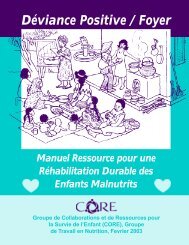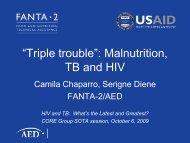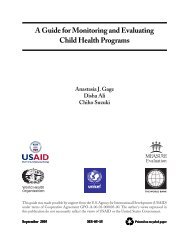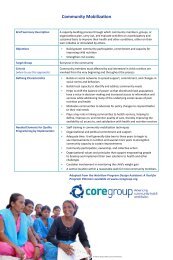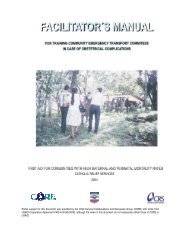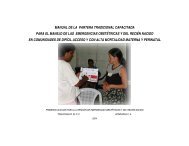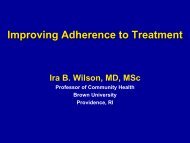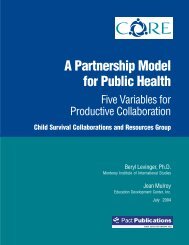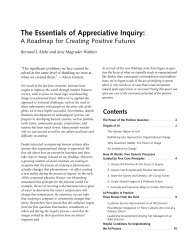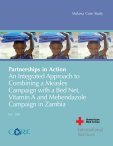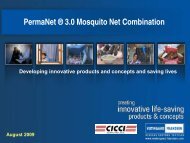Malaria Advocacy Training Workshop Nairobi, Kenya - CORE Group
Malaria Advocacy Training Workshop Nairobi, Kenya - CORE Group
Malaria Advocacy Training Workshop Nairobi, Kenya - CORE Group
You also want an ePaper? Increase the reach of your titles
YUMPU automatically turns print PDFs into web optimized ePapers that Google loves.
<strong>Malaria</strong> <strong>Advocacy</strong> <strong>Training</strong> <strong>Workshop</strong> | 22nd–23rd January 2007Table of ContentsForeword 2Executive Summary 3Acronyms 5Opening RemarksBy Mr. Peter McOdida - KeNAAM Chairperson 6<strong>Workshop</strong> Expectations by Participants 6Presentation on KeNAAMBy Christine Pekeshe 7Presentation on <strong>Malaria</strong> <strong>Advocacy</strong> in <strong>Kenya</strong>By Mr. Gerald Mwangi Walterfang – CEO KeNAAM 9Presentation on VOICES for <strong>Malaria</strong> “VOICES” A Global <strong>Malaria</strong> <strong>Advocacy</strong> ProjectBy Areana Quinônes - <strong>CORE</strong> 11Presentation on <strong>Advocacy</strong>, Communication and Social Mobilization ConceptsBy: Bertrand Patrick – Global Health Advocates 13Presentation on Overview of <strong>Advocacy</strong>By: Bertrand Patrick – Global Health Advocates 15Presentation on Drop the <strong>Malaria</strong> Tax CampaignBy: Louis Da Gama – Global Health Advocates 17Presentation on how CSO Coalition Networks evolveBy: Allan Ragi, Executive Director KANCOPresented by Bertrand Patrick – Global Health Advocates 19<strong>Group</strong> Work<strong>Group</strong> Presentations 21Presentation on the steps of developing an Effective MessageBy Bertrand Patrick – Global Health Advocates 24Conclusion and Way Forward 26Appendix 1 Graph showing an example of Media coverageagainst Funding for AIDS in USA 28Appendix 2 Tips on developing an Effective <strong>Advocacy</strong> Message 29Appendix 3 Example of an Effective Message 30Appendix 4 Indicators for measuring the progress of <strong>Advocacy</strong> Strategies 32Appendix 5 Report on Fact Finding Mission to Kilifi 33Appendix 6 Draft Programme – <strong>Malaria</strong> <strong>Advocacy</strong> <strong>Training</strong> <strong>Workshop</strong> 36Appendix 7 Participant Listing 38Working Together for a <strong>Malaria</strong> Free <strong>Kenya</strong> | 1
<strong>Malaria</strong> <strong>Advocacy</strong> <strong>Training</strong> <strong>Workshop</strong> | 22nd–23rd January 2007ForewordHeld on the 22-23rd of January 2007, The <strong>Malaria</strong> <strong>Advocacy</strong> <strong>Training</strong> <strong>Workshop</strong> brought togethermembers of the network in an exploratory meeting to consider aspects of effective malariaadvocacy.The workshop grew out of the KFAC3 recommendations. Indeed, following theKFAC3, plus other achievemnets, KeNAAM has broadened its partnership base, gaining thesupport of the <strong>CORE</strong> <strong>Group</strong> and The Johns Hopkins Centre for Communications Programmes.The workshop was well attended, with admirable representration from KeNAAM’s affiliates. Itwas well organised about presentations, blending theory and praxis. In his presentation on<strong>Malaria</strong> <strong>Advocacy</strong> in <strong>Kenya</strong>, the CEO of KeNAAM Gerald Mwangi Walterfang walked the participantsthrough what has been done (and what is proposed) about malaria advocacy in <strong>Kenya</strong>.He gave a pithy discussion on the notion of the VOICES project, and apprised participantsabout what success had already been attained (and with whom). Finally, he ably surfaced thechallenges and opportunities of advocacy, inviting participants to consider a credible nationalstrategy. On her part, Areana Quinônes—Voices of <strong>Malaria</strong> Control—gave a broader perspective,considering advocacy from a regional and international perspective. Among the salientissues she raised was the need for the development of model advocacy strategies. Likewise, sheasserted that network members should use empirically based evidence in doing advocacy andexploit strategies that enjoy demonstrated validity and reliability.Bertrand Patrick’s led a presentation—<strong>Advocacy</strong>, Communication, and Social Mobilization--thatwas perhaps the most important contribution to the workshop (besides the practical session).His talk was instructive about important attributes of advocacy, including social mobilization(which is an important avenue for advocacy). He also provided a helpful overview of componentsof advocacy (in rounding out).Loius Da Gama’s, Drop the Tax Campaign, story was informative about the injurious effects ofregressive and punitive taxes on malaria control. His emotive (but cogent) treatise would beuseful in shaming governments about these forms of taxation. Allan Rigi (presented byBertand Patrick) traced the origin, development, attainments, and challenges of CSO’s, entitiesthat would be useful mediums in the implementation of enhanced malaria control, thetype of which an effective advocacy campaign might furnish.To conclude, participants were invited to an important practical session, in which they wererequired to demonstrate various skills and knowledge (gained from the workshop). The workshopset the stage for the formulation of a national advocacy strategy.Working Together for a <strong>Malaria</strong> Free <strong>Kenya</strong> | 2
<strong>Malaria</strong> <strong>Advocacy</strong> <strong>Training</strong> <strong>Workshop</strong> | 22nd–23rd January 2007Executive SummaryThe efforts of stakeholders in malaria control—perhaps the most notable pubic health concernin Africa—appear stymied, restrained by insufficient resources and inadequate awareness.Stakeholders are, thereupon, thoughtful in seeking to optimize advocacy to unlock theseresources and thereby improve interventions and awareness.The recent KeNAAM <strong>Malaria</strong> <strong>Advocacy</strong> <strong>Training</strong> <strong>Workshop</strong> was instructive about aspects of effectiveadvocacy. Its objective was to consolidate views of members towards developing and executinga lucid advocacy strategy. That strategy would help secure the following goals: (i) theMoH would commit more resources to malaria control, (ii), the GoK would treat malaria as anurgent public health problem, and (iii) stakeholders would enhance their advocacy capacityby employing champions drawn from individuals and corporations.Apparently, there is no universal or commonly accepted definition of the term “advocacy”.<strong>Advocacy</strong> has common themes and characteristics for all that—concepts that Bertrand Patrickably defined. But perhaps the more significant term, in that vein, was the notion of SocialMobilization. The term is seminal because it forms the conceptual and operational gridthrough which to increase the status of malaria control in political, social, and economic discourse.Such effective advocacy entails giving voice to the voiceless, as Gerald M. Walterfangaptly termed it. Such advocacy ought to be science based, purposeful, collaborative (usingcoordinated country strategies), and to collaborate with the media in powerful and creativeways, to cite a few.Areana Quinônes delivered a pithy presentation, one that brought out the international character,implications, and opportunities of advocacy. She deftly presented a dimension of advocacythat local stakeholders would do well to absorb. Optimal advocacy ought to incorporatestrategies that flow from the data; equally, they ought to promise support for enhanced malariaR&D. She rightly said that there is a need for a model advocacy strategy. Indeed, effectiveadvocacy should be global in orientation, robust in approach, innovative in nature, and directedin tone.Perhaps the most significant event in the workshop was the <strong>Group</strong> Work session. During thatpractical session, participants were required to demonstrate their competence about applyingthe central planks of advocacy—the Who, the What, and the How—put differently, its issues,processes, and goals. The participants demonstrated considerable promise by ably exhibitingthese canons of advocacy. They were put to test regarding their conceptual, analytical, interpersonalskills, and problem solving abilities. Through the group work, they learn to appreciatethe need to have competent strategies. They also recognized that advocacy enterprises arecollaborative, needing effectual coordination.Together, the workshop was important because it made participants more aware of the requirementsof successful advocacy. What is more, it made them understand that the problem ofmalaria control will only be solved substantially (in consonance with the MDG’s) once thenetwork has formulated and implemented an effective advocacy plan. On the other hand, thenetwork can derive enormous opportunities in advocacy. For one, advocacy is worthwhile. Itis a high return venture, with a huge potential for raising resources.So then, the network should move speedily to isolate and remove all barriers to advocacy. Itcan draw enormous benefits from using champions and champion organizations, not to men-Working Together for a <strong>Malaria</strong> Free <strong>Kenya</strong> | 3
<strong>Malaria</strong> <strong>Advocacy</strong> <strong>Training</strong> <strong>Workshop</strong> | 22nd–23rd January 2007tion the youth. What is more, it should consider exploiting existing capacities to raise awarenessabout malaria control, by using trained folk who are already working in the communityin the domain of HIV/AIDS workers. Recent scientific findings linking malaria with the spreadof HIV/AIDS only serves to buttress the need at thinking. It should compile a national advocacystrategy that is popularly accepted and owned. The bulk of the workshops’ objectiveswere attained. But perhaps the only significant set back was the failure to deliberate on theKilifi study. Once published, that report should be illustrative on vital aspects of advocacy. Atany rate, the workshop agreed to set up a taskforce to help realize its advocacy goals.Working Together for a <strong>Malaria</strong> Free <strong>Kenya</strong> | 4
<strong>Malaria</strong> <strong>Advocacy</strong> <strong>Training</strong> <strong>Workshop</strong> | 22nd–23rd January 2007ACCRONYMSACTION TB – Project on <strong>Advocacy</strong> in TBACT-UP – Activist NGO group on AIDSAGM – Annual General MeetingAKMLSO - Association of <strong>Kenya</strong> MedicalLaboratory Scientific OfficersAMREF – African Medical Research FoundationART – Antiretroviral TherapyCBO – Church Based OrganizationsCIDA – Canadian International DevelopmentAgencyC-IMCI – Community IMCICMH – Commission for Macroeconomic andHealth<strong>CORE</strong> – Child survival Collaboration andResearch foundationCOTU – Central Organization of Trade UnionCRS – Catholic Relief ServicesCSO – Civil Society OrganizationsCWShops - Cry for the World Shops/SustainableHealth Enterprise Foundation-SHEFDOMC – Division of <strong>Malaria</strong> ControlEARN – East Africa Roll Back <strong>Malaria</strong> NetworkFBO – Faith Based OrganizationsGF – Global FundGoK – Government of <strong>Kenya</strong>HIV/AIDS – Human Immuno-deficiencyVirus/Acquired Immuno DeficiencySyndromeICIPE – International Research of InsectPhysiology and EcologyIEC - Information Education CommunicationBCC - Behaviour Change CommunicationIMCI – Integrated Management of ChildhoodIllnessesKeNAAM – <strong>Kenya</strong> NGO Alliance Against <strong>Malaria</strong>M&E – Monitoring and EvaluationMAP - Medical Assistance ProgrammeMERLIN – Medical Emergency ReliefInternationalMOH – Ministry of HealthNGO – Non- Governmental OrganisationNMBP – National <strong>Malaria</strong> Business PlanNMS – National <strong>Malaria</strong> StrategyMDG – Millennium Development GoalsPLWHA – People living with HIV/AIDSPSA – Public Service AnnouncementPW – Pregnant WomenR&D – Research and DevelopmentRBM – Roll Back <strong>Malaria</strong>RESULTS UK – A grass root Organization thatcampaigns to governmentSTD – Sexual Transmitted DieseaseTA – Technical AssistanceTB – TuberculosisToR – Terms of ReferenceTWG – Technical Working <strong>Group</strong>U5 – Children Under the age of 5YrsUN – United NationsUNGASS – United General Assembly onHIV/AIDSWV – World VisionWorking Together for a <strong>Malaria</strong> Free <strong>Kenya</strong> | 5
<strong>Malaria</strong> <strong>Advocacy</strong> <strong>Training</strong> <strong>Workshop</strong> | 22nd–23rd January 2007Opening RemarksPeter McOdida – KeNAAM ChairpersonDear Participants,You are most welcome to this <strong>Malaria</strong> <strong>Advocacy</strong> <strong>Training</strong> <strong>Workshop</strong>. This workshop seeks toexplore strategies and methods of fruitful malaria advocacy. Thereby, the theme of the workshopis, fittingly termed as “Common Messaging on <strong>Malaria</strong>”. Effective advocacy is instrumentalin our mandate of minimizing, if not eliminating, the suffering of pregnant womenand children under five, who are the most sucseptible to the malaria parasite. You are invitedto share your views and feelings freely. We need to learn from each other.I am thankful to all of you for finding time to attending this workshop. I am particularly gratefulto Areana from <strong>CORE</strong> for her attendance and support. Just so, I appreciate the presence ofBertrand Patrick and Louis Dagama for having made it for this workshop at short notice.Let us have fruitful discussions.Asante Sana!<strong>Workshop</strong> ExpectationsRegarding advocacy, the following questions were pertinent:1. What does it mean and entail?2. What is its nature, scope, and challenges?3. What distinguishes it from IEC/BCC?4. What are its global best practices?5. What can KeNAAM do to improve its skills and techniques about advocacy?6. What strategies, methods, and techniques would be applicable in the <strong>Kenya</strong>n context?7. How can it be tailored to fit <strong>Kenya</strong>’s socio-economic circumstances?8. What sort of materials would be required?9. How might the youth be mobilized to augment existing advocacy campaigns?10. What has KeNAAM achieved with regard to the <strong>Malaria</strong> Youth Program?11. What are the best practices regarding malaria treatment?12. How would advocacy boost vector control?13. What impact does advocacy have on malaria treatment at the grassroots level?14. How might the VOICES initiative be boosted?Working Together for a <strong>Malaria</strong> Free <strong>Kenya</strong> | 6
<strong>Malaria</strong> <strong>Advocacy</strong> <strong>Training</strong> <strong>Workshop</strong> | 22nd–23rd January 2007Presentation on KeNAAMBy: Christine Pekeshe – Communication Officer KeNAAMWhat is KeNAAMFounded in 2001, it is an alliance of NGO’s that collaborate—through networking—in programsaimed at not only preventing/managing malaria, but also, in mitigating its socio-economiccosts. It draws support from key stakeholders in <strong>Kenya</strong>, including the Ministry ofHealth (MoH). Indeed, in its mission, KeNAAM recognizes the strategic role played by MoH,through the Division of <strong>Malaria</strong> Control (DOMC), in fighting malaria in fealty to the National<strong>Malaria</strong> Strategy (NMS). KeNAAM deems as partners any number of bilateral and multilateralagencies, not to mention private sector and donor communities that aim to “Roll Back <strong>Malaria</strong>in <strong>Kenya</strong>”. Its immediate goal is to reduce malaria mortality by 60 per cent before 2010, inconsonance with the Abuja Declarations of 2000, through synergistic scaling up of RBMinterventions.KeNAAM’s VisionTo forge effective partnership, with local and foreign entities, to have a malaria free <strong>Kenya</strong>, inline with the Millennium Development Goal (MDG 6,7 and 8).MembershipIs open to any NGO, FBO, and CBO networks that tackle malaria and IntegratedManagement of Childhood Illnesses (IMCI).KeNAAM encourages private sector partnerships.Guiding PrinciplesTo create a conducive environment to realize optimal networking.To encourage stakeholders to optimize their potential in delivering effective and appropriateinterventions to households.Membership CommitmentContributing to joint work planning (bundle proposals, implementation, baseline surveys,and research).Adhering to best practices in malaria prevention, control, and communication.Accepting that the overriding objective is to churn out malaria interventions, regardlessof the organization.Scaling up of malaria interventions to reduce the burden of malaria among vulnerableand needy communities.NetworkingKeNAAM’s present membership stands at 45, enhancing its advocacy and increasing thevisibility of its programs.KeNAAM has established close partnerships with MoH, EARN, RBM Secretariat, UNICEFand <strong>CORE</strong> in hosting important malaria workshops.Working Together for a <strong>Malaria</strong> Free <strong>Kenya</strong> | 7
<strong>Malaria</strong> <strong>Advocacy</strong> <strong>Training</strong> <strong>Workshop</strong> | 22nd–23rd January 2007KeNAAMs ObjectivesTo develop a close working relationship with the MoH.To foster the use of evidence based malaria interventions.To secure higher compliance among members of NMBP.To support and strengthen the use of M&E systems by members.To promote excellent performance among members.To develop advocacy policies and create malaria intervention awareness.Specific ObjectivesTo provide an organizational framework that advocates for the prioritization of malariaissues on the national agenda, through social and administrative mobilization of thecivil society, through RBM (with a particular emphasis on IMCI).To attract new sources of funding for scaling up RBM and IMCI activities.To enhance greater engagement of NGO’s and private sector actors in IMCI/RBM activitiesat all levels of provincial administration.To provide leadership and coordination for stakeholders in the scaling up of RBM interventionsand C-IMCI activities.To facilitate better domestic understanding of national and global health policies, issues,and concerns.To provide a grid that minimizes duplication of effort and ensures that implementationgaps are identified and addressed.To accelerate implementation and scaling up of best practices about Roll Back <strong>Malaria</strong>.What does KeNAAM seek to do?To influence policy makers to prioritizing malaria control/management.To provide stakeholders with knowledge about aspects of malaria.To carry out case management at the community level, by effectively using ArtemisinCombination Therapy (ACT) and Home Based Management.To enhance “<strong>Malaria</strong> in pregnancy interventions” through Focused Ante-Natal Care-FANC at the facility level (and recommended preventive approach through IntermittentPresumptive Treatment-IPT) 1 an 2.To promote the use of Insecticide Treated Nets – ITNs.To integrated Vector Management through the use of ITNs, Larviciding, and IndoorResidual Spraying, to cite a few.Working Together for a <strong>Malaria</strong> Free <strong>Kenya</strong> | 8
<strong>Malaria</strong> <strong>Advocacy</strong> <strong>Training</strong> <strong>Workshop</strong> | 22nd–23rd January 2007Presentation on<strong>Malaria</strong> <strong>Advocacy</strong> in <strong>Kenya</strong>By: Gerald Mwangi Walterfang - CEO KeNAAMOne of KeNAAM’s main objective is to introduce malaria advocacy, by giving a voice to thevoiceless sufferers of malaria. KeNAAM deems working on the VOICES project a privilege.VOICES <strong>Kenya</strong> (June 2006)Project Goal: To break down barriers hindering the use of essential malaria interventionsObjectives (By 2008):To increase GoK’s allocation of resources in malaria control.To heighten the visibility of malaria as an urgent public health issue.To increase the number of champions and champion organizations advocating to policymakers.VOICES <strong>Kenya</strong><strong>CORE</strong> partners with KeNAAMThe <strong>CORE</strong> group provides:i. Technical Assistanceii. <strong>Training</strong>iii. Track and Report Resultsiv. Collaborates with VOICES Team in the US and MaliKeNAAM will aim at:i. Developing and implementing advocacy strategy for <strong>Kenya</strong>, training members andidentifying new advocates-Why NEW?KeNAAMs <strong>Advocacy</strong> role thus far includes:Collaborating with TWG at both country & international level (Global <strong>Advocacy</strong> TaskForce).Highlight malaria issues in media.Seeking resources for multi-sectorial advocacy.Highlighting the concern of CSO’s over scarce malaria resources (Global FundPartnership Forum).Developing an advocacy strategy to incorporate and support the MoH <strong>Malaria</strong> communicationstrategy.Some of KeNAAMs advocacy country partners include:NGOs (KeNAAM Members)Division of <strong>Malaria</strong> Control-(DOMC)MediaPrivate SectorMinistry of EducationWorking Together for a <strong>Malaria</strong> Free <strong>Kenya</strong> | 9
<strong>Malaria</strong> <strong>Advocacy</strong> <strong>Training</strong> <strong>Workshop</strong> | 22nd–23rd January 2007Presentation onVOICES for <strong>Malaria</strong> “VOICES”A Global <strong>Malaria</strong> <strong>Advocacy</strong> ProjectBy: Areana Quinônes - <strong>CORE</strong><strong>CORE</strong> works with partners in the US, UK, EU and in 4 countries in Africa--Ghana, <strong>Kenya</strong>, Mali,and Mozambique. Its project goal is to eradicate malaria through a coordinated global advocacyeffort that promotes proven control strategies and increased malaria research and development.Any initiative, such as the VOICES advocacy project, will be fruitful in wider global advocacy,a useful model for other African countries, with which <strong>CORE</strong> works. It will engender informationwith which to influence donors and the international community.To achieve this, VOICES will use a two pronged approach:Initiate a global call to action with key high-level audiences and media worldwide (linkwith IFRC on joint international advocacy efforts).Break down both policy and resource barriers in four developing country advocacy projects.VOICES global call to action seeks to attain the following:Create new and powerful voices.Reach out to policy makers towards increasing budgetary allocations.Improve current advocacy efforts.In summary, the VOICES advocacy project will:Increase attention to malaria on the global stage and country level.Involve new voices and new partners in the global campaign.Procure more resources to malaria control and R&D.Implement four country advocacy programs that can be scaled up and/or replicated inother countries.Develop a collection of effective, evidence-based, tools for malaria advocates to use.Plenary and DiscussionCommentWhat is stopping <strong>Kenya</strong> from accessing international donor funding and getting partners towork with?When Roll Back <strong>Malaria</strong> began in 1998, a study showed that $200 million had been used tocontrol malaria globally. In 2006, this figure had risen to $1 billion. It will be difficult to sustainor increase that level of funding if countries are using the same sub optimally or ineffectively.Working Together for a <strong>Malaria</strong> Free <strong>Kenya</strong> | 11
<strong>Malaria</strong> <strong>Advocacy</strong> <strong>Training</strong> <strong>Workshop</strong> | 22nd–23rd January 2007QuestionAre the research findings for Kilifi available?ResponseYes! They are out and will soon be made available at the end of this training. (See appendix 5Report on Kilifi Findings)CommentSince malaria is the leading killer of children in Sub Saharan Africa, we should get as manyvoices as we can to fight malaria vis a vis the efforts expanded on HIV/AIDS.CommentThe use of youth in malaria advocacy is a novel idea that promises enormous benefits. Itshould be replicated elsewhere in the continent. In that connection, Zambia has alreadyshown leadership through the Scouts movement.Comment<strong>Malaria</strong> mainly affects the voiceless—PW and U5—as opposed to HIV/AIDS, that affects peopleof all age groups. It has become a way of life for many people. People suffering frommalaria seem concerned merely with dealing with the symptoms of the illness by procuringdrugs. These people seem nonchalant about preventing the illness. This attitude needs to bereversed.QuestionHow come countries in the West/North America have eradicated malaria and not in Africa?CommentPeople have become complacent in fighting malaria. Presumably, it is not life threatening asHIV/AIDS is to the West and North America. It is worthy to note that the US military does carrryout extensive research on malaria since the Vietnam war.Working Together for a <strong>Malaria</strong> Free <strong>Kenya</strong> | 12
<strong>Malaria</strong> <strong>Advocacy</strong> <strong>Training</strong> <strong>Workshop</strong> | 22nd–23rd January 2007Presentation on<strong>Advocacy</strong>, Communication,and Social Mobilization General ConceptsBy: Bertrand Patrick – Global Health AssociatesWhat is <strong>Advocacy</strong>?It is the process of influencing policy makers to change policies and practices.It is the use of directed strategies—through communication, branding, marketing, publicity,and coalition building—to harness pressure for change<strong>Advocacy</strong> in malaria controlThe aim is to promote issues of malaria control in political and developmental discourse, evidencedby increased (and sustainable) financial outlays.What is communication?It includes the following:Activities designed to increase knowledge among the public about malaria and its control.Activities aimed at enhancing interpersonal communication between patients and programproviders leading to behavioral change. For example, campaigns to teach peoplehow to sleep under nets, etc.What is Social Mobilization?It is to influence and involve relevant segments and sectors of the society, e.g. community, privatesector, etc, towards dealing with a serious social problem. It entails the harnessing ofenergies, commitments, resources, and situations to move people to a common goal.Social Mobilization in <strong>Malaria</strong> ControlThese constitute the directed activities that are designed to increase the mobilization of communitiesto fight and eliminate malaria.Plenary and DiscussionComment<strong>Advocacy</strong> is a process with an outcome. Its salient attribute is that it seeks change. It isdeemed successful if it attains behavioral change of policy makers. To carry out effective advocacy,proponents of the same need to understand what might hinder their efforts i.e. barriersto advocacy.CommentNo universally accepted definition of advocacy exists. Stakeholders need to stipulate theirown definitions.Working Together for a <strong>Malaria</strong> Free <strong>Kenya</strong> | 13
<strong>Malaria</strong> <strong>Advocacy</strong> <strong>Training</strong> <strong>Workshop</strong> | 22nd–23rd January 2007CommentEffective advocacy should lead to change and increased resources.To do effective advocacy, proponents need to believe that the process is rewarding, that itchurns out much more than the amount invested.Example 1:If you invest $2 to $5 million on advocacy campaigns, you can mobilize more than $100 million.In the case of Tuberculosis, 10 yrs in advocacy campaigns with a $15 million budgetyielded to $1 billion being raised.Example 2:The advocacy activities regarding the Global Fund required about $10 to $12 million in 2004;however, it eventually raised $3.5 billion.(Source: Louis Da Gama)Working Together for a <strong>Malaria</strong> Free <strong>Kenya</strong> | 14
<strong>Malaria</strong> <strong>Advocacy</strong> <strong>Training</strong> <strong>Workshop</strong> | 22nd–23rd January 2007Presentation on an Overview of <strong>Advocacy</strong>By: Bertrand Patrick – Global Health AssociatesMain Components of <strong>Advocacy</strong>Assess the political situation – “With careful calculations, one can win; with less, one cannot.”Document the situation – “<strong>Advocacy</strong> without evidence is unsustainable.”Package the message – “The facts don’t speak for themselves.”Apply pressure through the media – “If you do not exist in the media, you do not exist inpolitics.”Involve new partners – “There is strength in numbers and diversity.”Use “Insider Strategies” – “It is not what you know, but who you know that counts in politics.”Evaluate the Results and Build on SuccessDifferentiating various types of <strong>Advocacy</strong>No. Type Audience Tactics Examples1Indirect <strong>Advocacy</strong> 1a. Research <strong>Advocacy</strong>Opinion LeadersPolitically relevant researchBudget AnalysisPolicy AnalysisOpinion pollsCMH reportGlobal Plan 22b. Coalition <strong>Advocacy</strong>MultipliersConventionPartner ForumsWeb-Based disseminationNewslettersStop TB PartnershipRBM Partnershipc. Mass <strong>Advocacy</strong>SustainersInternet ActivismPetitionsMass eventsCelebritiesElectoral ProcessesCause-related marketingPopular mediaOne CampaignRED CampaignDirect <strong>Advocacy</strong> 2a. Bureaucratic <strong>Advocacy</strong>Political EnablersCommuniqu`sDeclarationsTargetsPledgesUNGASSb. Protest <strong>Advocacy</strong>Political ObstructersMarchesBoycottsCivil DisobedienceDemonstrationsACT-UPc. Legal <strong>Advocacy</strong>CourtsClass action suitsLitigationd. Political <strong>Advocacy</strong>Decision MakersParliamentaryDelegationsEditorial Board MeetingsLocal hearingsDirect correspondencePersonnel MeetingsACTION TB1. Indirect <strong>Advocacy</strong> – Example: to try and shape the political agenda of a country.2. Direct <strong>Advocacy</strong> - Those activities that are directly focused on a specific public.Working Together for a <strong>Malaria</strong> Free <strong>Kenya</strong> | 15
<strong>Malaria</strong> <strong>Advocacy</strong> <strong>Training</strong> <strong>Workshop</strong> | 22nd–23rd January 2007Presentation onDrop the <strong>Malaria</strong> Tax Campaign 4By: Louis DaGama – Global Health AdvocatesAs it is, only about two per cent of children under five years and who are susceptible to malaria,sleep under ITN’s. That regrettable event is partly due to the application of a regressive taxationpolicy, with deprived communities spending upto a week’s wages to procure ITN’s. It isimperative that this form of punitive taxation be removed. Indeed, were national governmentsto do so, they would be demonstrating unequivocally their commitment to malariacontrol. <strong>Advocacy</strong> that brings out the regressive and punitive character of existing taxationpolices would thus be appropriate.Summary of Participants ContributionsKnowledge about the etiology, control, and treatment of malaria is generous—mature. Still,progress towards the eradication of malaria, let alone the attainment of the Abuja Goals, issluggish (if not torpid in many respects). The stymied growth towards the realization of thesegoals is referable to a lack of mainly human and financial resources. Accordingly, then, advocacybecomes an attractive instrument with which to mobilize much needed resources—human, capital—to intensify and quicken the fight against this parasite. <strong>Advocacy</strong> shouldengender increased budgetary allocations and heightened awareness. At the internationallevel, funding for malaria control is available, only donors seem keen to support initiativesthat observe prudent financial stewardship, initiatives that accomplish appreciable or measurablebenefits at the level of lived experience—initiatives that flow from research findings. Inshort, effective advocacy should not only realize tangible outcomes—increased financial supportfrom GoK, but also, change lives or behavior of beneficiaries in important and tangibleways. Put differently, it needs to be directed, among other characteristics—designed to procure(favorable) predetermined outcomes.Since malaria is the leading cause of death for children in Africa South of the Sahara, malariaadvocacy should strive to influence policy direction towards treating the parasite as the leadingpublic health problem in Africa. Significantly, research shows that malaria is an importantfactor in the spread of HIV/AIDS. Likewise, advocacy should change attitudes at the grassrootslevel, by inducing a greater sense of urgency and responsibility, with communities that areliable to the parasite regarding the same as a problem to be controlled, and not just treated.To sum up, advocacy is effective if it yields results, more money, better behavior—better collaborationsamong stakeholders, to cite a few.Plenary and DiscussionQuestionWhat are the bottlenecks experienced in advocacy campaigns?ResponseSome of the bottlenecks include the following:Governments in Africa are complacent, uncommitted to their pledges.The civil society is weak.4 For more information see www.MassiveEffort.org/dropthetaxWorking Together for a <strong>Malaria</strong> Free <strong>Kenya</strong> | 17
<strong>Malaria</strong> <strong>Advocacy</strong> <strong>Training</strong> <strong>Workshop</strong> | 22nd–23rd January 2007Lack of coordination – Efforts of stakeholders is not coordinated.Inefficient procurement systems.Many countries fail to uphold health policies to which they have expressed commitment.For instance, some governments have promised their people e.g. free drugs onlyfor the people down at the grass root level who end up paying for the same.QuestionHow might we sustain momentum when leadership changes, e.g., at the UN?ResponseCreate champions who speak the same message consistently. Stakeholders should have a commonvoice/message. They should agree on financial inputs and outputs and on effectivestrategies, methods, and techniques.CommentWe need to put a “face on” malaria and carry out advocacy on that basis, unlike HIV/TB whereyou can see the people living with the disease, malaria needs a face for those affected by thedisease and hence the need for “VOICES” with “known faces” to advocate for malaria.CommentWe should fully utilize opportunities to address malaria by using existing capacities, forinstance, by relaying the information through skilled community health workers who arealready proficient in carrying out other public health problems, such as HIV and its treatmentand maternal health at the community level.ObservationWe should do write-ups and newsletters to reach the youth, in the same way that other entitiesuse these media to reach out to the youth on any number of social and other issues withan aim of increasing the malaria “voice”.QuestionHow can we make local issues important at the international level?ResponseConsistent messaging!CommentMany champions are willing to lobby for malaria. Still, these people are innocent about whatto do. We should reach out to them and work collaboratively, whilst nurturing trust and confidence5 .ExampleYvonne Chakachaka is a renowned musician, has a global voice and is widely respected bothin Africa and Globally. She is a well-known champion on malaria. Others in <strong>Kenya</strong> are to besought.QuestionWhat is activism?Activism – It is related to advocacy. It serves to raise the profile of an issue. For instance,activist would use street demonstrations to demand that government take action to addressaspects of malaria management. <strong>Advocacy</strong> entails people approaching policy makers with aview to convincing them to change.5. A champion is an individual who is: (1) Influential, (2) respected both locally and globally.Working Together for a <strong>Malaria</strong> Free <strong>Kenya</strong> | 18
<strong>Malaria</strong> <strong>Advocacy</strong> <strong>Training</strong> <strong>Workshop</strong> | 22nd–23rd January 2007Afternoon SessionPresentation onHow CSOs Coalition Network evolvedBy: Allan Ragi, Executive Director KANCOPresented by Bertrand Patrick – Global Health AdvocatesIntroductionThis presentation sought to illustrate what members of CSO’s can do to attain desired goals.<strong>Kenya</strong> CSO comprises of -Community Based Organizations (CBOs)Non-Governmental Organizations (NGOs)Faith Based Organizations (FBOs)PLWHA OrganizationsThe foregoing organizations came together to respond to enquiries and discussions regardingthe implementation and reporting of the <strong>Kenya</strong> Global Fund Program.ChallengesMistrust among CSOsPoor communication and reporting mechanismsDivided loyaltyUnfair competition from government and othersPoor public imagePoor coordinationUndefined roles and responsibilitiesIn time, CSOs agreed to form the United Civil Society Coalition against STD and <strong>Malaria</strong>.The tasks of this coalition included:To assess government compliance with recommendations of the Habib Report.To lobby and advocate for greater accountability.To consolidate voices into ONE cohesive voice vis a vis the Global Fund.The CSO coalition is, therewith, supportive of the following:That there should be 140,000 patients on ART by December 2006.That the CSOs should develop a Work Plan and Budget with clearly defined and measurabletargets.That the matters raised in the Audit Report of 2004 should be addressed.That there is need to ensure compliance with the 9th board decision.Working Together for a <strong>Malaria</strong> Free <strong>Kenya</strong> | 19
<strong>Malaria</strong> <strong>Advocacy</strong> <strong>Training</strong> <strong>Workshop</strong> | 22nd–23rd January 2007AchievementsLobbied for the strengthening of the Principle Recipient.Lobbied the MoH to appoint a new GF Program Coordinator.Established the United Civil Society Coalition on AIDS, TB, and <strong>Malaria</strong>.Collaborated with other members of the CSO to lobby the GF Secretariat in Geneva toapprove Phase II of the HIV/AIDS fund to <strong>Kenya</strong>.ChallengesDifficulty in sustaining commitments.Problems in conflict resolution.Poor Communication.Lack of capacity to implement programs and account for resources.<strong>Group</strong> WorkAssignmentProject Goal: The project is to break down barriers that affect the use of essential malaria interventions.Participants were divided into three subgroups to work on one of the following three objectivesthe needs assessment tools).(usingObjectives:1. By 2008, GoK’s resource allocation for malaria control will have increased. (Passed on to group1)2. By 2008, the visibility of malaria as an urgent issue requiring immediate attention will haveincreased. (Passed on to group 23. By 2008, the number of champions and champion organizations involved in advocacy willhave increased.(Passed on to group3)Working Together for a <strong>Malaria</strong> Free <strong>Kenya</strong> | 20
<strong>Malaria</strong> <strong>Advocacy</strong> <strong>Training</strong> <strong>Workshop</strong> | 22nd–23rd January 2007Day 2Morning Session<strong>Group</strong> sessionpresentation focused on the following:1. WHO are you convincing? (Be specific).2. WHAT will you convince them of? Any research needed/where it comes from.3. HOW will you convince them? Details needs/budgets and where.Presentation from <strong>Group</strong> 1A) WHO1. Lucy Kibaki (First Lady)Others Champions IdentifiedManu Chandaria (Entrepreneur/Philanthropist)Paul Tergat (Marathon Runner)Catherine Ndereba (Marathon Runner)Wangari Maatha (Environmentalist/Politician/Nobel Lauréate)Respected business corporations, e.g., <strong>Kenya</strong> AirwaysC) HOWHow can she be reached?Through social organizations and groups of which she belongs to, e.g. church and womengroups.2. Charity Ngilu (Minister of Health)How can she be reached?Through senior civil servants at the MoH. We should even strive to make these people(PS/DMS/Heads of Divisions) partner with us.Through social organizations, e.g. women groups, churches, political party offices, andthe like.3. Parliamentary Health CommitteeHow can they be reached?Through organizing a workshop for them.Through formal meetings.4. Parliamentary caucus on malaria5. Aga Khan FoundationWorking Together for a <strong>Malaria</strong> Free <strong>Kenya</strong> | 21
<strong>Malaria</strong> <strong>Advocacy</strong> <strong>Training</strong> <strong>Workshop</strong> | 22nd–23rd January 2007B) WHATGet consensus among KeNAAM members regarding the advocacy strategy.Get itemized budgets from the MoH Division of Preventive and Promotive Health.Find out how much money is spent on the following items:i. Drugsii. Preventioniii. Logisticsiv. Human Resourcesv. Research Policy4. Ascertain the relevance and effectiveness of the extant malaria policy at the communitylevel.Presentation by <strong>Group</strong> 2WHO1. Director of Medical ServicesHOWWHOShare KeNAAM’s profile with the DMS.Provide the DMS with data about malaria morbidity and mortality.Convince the DMS to appreciate what KeNAAM stands for.Seek agreement with the DMS on probable structures in malaria prevention and treatment.Persuade the DMS to seek the support of the PS/Minister to increase budgetary allocationfor malaria treatment.We should book an appointment with the DMS to sell to him our agenda.We should develop some instruments with which to gather data from the DMS, e.g. aquestionnaire.We should request our secretariat to put together a force to analyze and interpret thedata, reducing the same into a presentable—easy to read—format.We should consider how increased allocations from MoH ought to look like.2. Francis Atwoli – COTU Secretary GeneralHOWWHOOur secretariat should organize an appointment to discuss the nature, scope, and challengesof our endeavors.We should carry current data and other illustrations to show the scope of the adverseeffects of malaria. Data obtained from the DMS would be functional.We should justify to the Secretary General the need for increased funding (and to whatactivities such money should be allocated to).3. Maendeleo ya Wanawake 6 ChairpersonHOWExplain the effects of malaria on pregnant women and children.6. An association for the advancement of womenWorking Together for a <strong>Malaria</strong> Free <strong>Kenya</strong> | 22
<strong>Malaria</strong> <strong>Advocacy</strong> <strong>Training</strong> <strong>Workshop</strong> | 22nd–23rd January 2007WHOHOWYouth Organizations e.g. <strong>Kenya</strong> Scouts, St. Johns Ambulance , Red Cross, ReligiousYouth <strong>Group</strong>s.Faith Based OrganizationsThrough Seminars, <strong>Workshop</strong>s and Press events.Presentation by <strong>Group</strong> 3WHOWHATEric Wainana (Singer)Kipchoge Keino (Former athletics world champion)Ben Omondi (UN MDG Ambassadeur)Delineate our vision, values, and mission.Decide what kind of information he needs to absorb. We might want to let him appreciatethe following:i. Current data about the rate of morbidity and mortality due to malaria.ii. Spending on malaria in the current budget, showing the effects of these funds atthe community level, and conversely, the dearth in human and other resourcesneeded to prevent malaria.Find out what the champion expects from us.Identify a focal person to report and work with.Ascertain the costs of using the champion, e.g. venues/sponsoring etc.Determine the tenure of our relationship with the champion?3. HOWThrough the following avenues:Talk showsEventsMedia briefingsNewspaper articlesFace to faceAdvertisingThe foregoing can be attained through sufficient funding and through personal interactions.Working Together for a <strong>Malaria</strong> Free <strong>Kenya</strong> | 23
<strong>Malaria</strong> <strong>Advocacy</strong> <strong>Training</strong> <strong>Workshop</strong> | 22nd–23rd January 2007Afternoon SessionPresentation on thesteps on developing an Effective Message7By: Bertrand Patrick – Global Health AdvocatesStrategyUnderstand your target audience.Inform your target audience.Persuade your target audience.Move your target audience to Action.Characteristics of an Effective MessageSimpleConciseAppropriate languageContent consistent with formatCredible messenger/spokespersonTone and language consistent with messageElements of an Effective MessageContent/ideasLanguageMessenger/SourceFormat/MediumTime/PlaceMessage MediumFace to face meetingsExecute briefing packetsPublic ralliesFact sheetsPolicy ForumPoster and Flyers in public placesPositionPublic debatePress release7. See Appendix 3: Example of an Effective Message to the US Senate on the fight against <strong>Malaria</strong> showing the Problem, Evidence and ActionRequiredWorking Together for a <strong>Malaria</strong> Free <strong>Kenya</strong> | 24
<strong>Malaria</strong> <strong>Advocacy</strong> <strong>Training</strong> <strong>Workshop</strong> | 22nd–23rd January 2007Press conferenceContests to design posters, slogans etcDeveloping an advocacy messageAn <strong>Advocacy</strong> message should contain:StatementEvidenceExampleAction DesiredPlenary and DiscussionCommentFor your communication message to be effective, it should be well packaged. It should notbe overloaded.Working Together for a <strong>Malaria</strong> Free <strong>Kenya</strong> | 25
<strong>Malaria</strong> <strong>Advocacy</strong> <strong>Training</strong> <strong>Workshop</strong> | 22nd–23rd January 2007Conclusion and Way ForwardThe key issues for KeNAAM to address through advocacy are:1. To convince the government of <strong>Kenya</strong> to allocate more resources into the malaria budgetand to have a malaria vote in the budget.2. To identify additional champions from a cadre of people to intensify efforts at malaria controlin <strong>Kenya</strong>.3. To raise the visibility of malaria in <strong>Kenya</strong> to yield higher budgetary allocations and greaterunderstanding of its soci-economic impact.How can this be achieved?Come up with a Taskforce to address the foregoing issues.Carry out an internal advocacy campaign and furnish the same to the SteeringCommittee, a presentation that will finally be made at the KeNAAM AGM.Nurture wider coalitions and collaborations, e.g. through the youth, and corporateorganizations etc.Building and sustaining increasing pressure towards the commemoration of the Africa<strong>Malaria</strong> Day.What will make up a Taskforce?About 5 to 10 skilled and committed members. Questions that are raised within the taskforceshould be complied into a report.There will be Two Taskforces, that will focus on Two different areas:1. Task <strong>Group</strong> One – StrategyThis group will focus on the following:Ensuring the report from this training workshop becomes available.Using KeNAAMs SC and M&E framework.Developing a final Document and Strategy.Volunteer members in this group that will work together with the KeNAAM SteeringCommittee include:Edna Kamau – African Aid ConcernAthuman Chiguzo – CWShopsXavier Lugaga – ALEKWARichard Iyaya – <strong>Kenya</strong> Scouts AssociationLaban Onono – AKMLSOGerald Mwangi Walterfang - KeNAAMHassan Osman - GCHHezron Ngugi - AMREFEdward Mwangi - Ungana VolunteerEdmund Murage - Ungana CoordinatorChristine Pekeshe - KeNAAMWorking Together for a <strong>Malaria</strong> Free <strong>Kenya</strong> | 26
<strong>Malaria</strong> <strong>Advocacy</strong> <strong>Training</strong> <strong>Workshop</strong> | 22nd–23rd January 20072. Task <strong>Group</strong> 2 - InformationThis group will focus on the following:Information Research - identify the kind of information required.Identifying Champions to lead the advocacy campaign.Come up with a diary of events for 2007.Come up with a TOR for a consultant, if requiredVolunteer members in this group include:Jackson Mugambi – CRSMilkah Njunge – SUMITOMOMike Wanyama – MAPJames Sakwa – AKMLSOSamson Gichia - ICIPEChristine Pekeshe - KeNAAMTom Odula - AFPHezron Ngugi - AMREF/KeNAAMTeresia Omwoyo - World VisionNote: Need for a journalist in this group.TIMELINESNo. TASK Deadline Date1. <strong>Training</strong> <strong>Workshop</strong> Report Complete 31st January 20072. 1st Strategy Task <strong>Group</strong> Meeting 6th February 20073. Development of a Strategy 13th February 20074. VOICES M&E 13th February 2007Events to look out forDevelopment of KeNAAMs website- (by 28th February 2007)VOICES M&E Framework - (by 13th February 2007)Africa <strong>Malaria</strong> Day - (25th April 2007)Plenary and DiscussionQuestionHow will the membership within KeNAAM ensure that all information required will be madeavailable?ResponseBy the creation of a Task Force that will mainly be focused on Information and will bemade up of KeNAAM members with access to information from the organizations theywork for e.g. World Vision and MERLIN.The Task Force should also be able to identify both gaps and other information resourceareas.SuggestionPlan the advocacy campaign to coincide with the Africa <strong>Malaria</strong> Day on 25th April 2007 e.g.through a Press release and launch of the strategy.NoteFunding from VOICES for one year ends in May 2007 and subsequently for year two in May2008. It is imperative for KeNAAM to show results as a follow up of the training.Working Together for a <strong>Malaria</strong> Free <strong>Kenya</strong> | 27
<strong>Malaria</strong> <strong>Advocacy</strong> <strong>Training</strong> <strong>Workshop</strong> | 22nd–23rd January 2007Appendix 1Media Coverage and Funding for AIDS in the United StatesWorking Together for a <strong>Malaria</strong> Free <strong>Kenya</strong> | 28
<strong>Malaria</strong> <strong>Advocacy</strong> <strong>Training</strong> <strong>Workshop</strong> | 22nd–23rd January 2007Appendix 2Developing an Effective <strong>Advocacy</strong> MessageKeep the Written Message SimpleExample:PoorBetterMost Effective64 HIV-positive patients in the north-west and central states were evaluated over an 18 month period, beginningin January 1996. 91 eventually died from TB, 42 from Pneumonia.In some parts of our country, 34 percent of HIV-positive patients are dying from TB.In some parts of our country, one in three people with HIV are dying needlessly from TB. And becausethey are not being cured, they are infecting scores of HIV-negative people with the TB bacteria.No. Science<strong>Advocacy</strong>12345678910Detailed explanations are usefulExtensive qualification can be necessary for scholarly credibility.Technical language can add greater clarity and precision.Several points can be made in a single research paper.Be objective and unbiased.Build your case gradually before presenting conclusions.Support evidence is vital.Hastily prepared research and presentations can be discredited.The fact that a famous celebrity supports your research may beirrelevant.Many in the field believe that scientific truth is objective.Simplification is preferableExtensive qualification can blur your message.Technical jargon confuses people.Restricted number of messages is essential.Present a passionate compelling argument based on fact.State your conclusion first, then support them.Too many facts and figures can overwhelm the audience.Quick, but accurate preparation and action are often necessaryto take advantage of opportunities.The fact that a famous celebrity supports your cause may beof great benefit.Many in the field believe that political truth is subjectiveTarget your AudienceSome language or rhetoric will be meaningful to one audience but not to another. It is vital totailor our message so that it is appropriate for the target audience. Typically, people listen to amessage when it affects them or their concerns. We need to frame the information so that itappears relevant rather than remote.Working Together for a <strong>Malaria</strong> Free <strong>Kenya</strong> | 29
<strong>Malaria</strong> <strong>Advocacy</strong> <strong>Training</strong> <strong>Workshop</strong> | 22nd–23rd January 2007Appendix 3<strong>Malaria</strong> Messaging Summit - RESULTSOctober 27, 2006Policy/<strong>Advocacy</strong>MediaMessage Bucket 1 What is the issue? What is the issue?Message Bucket 2 Why should I care? Why should my readers care?Message Bucket 3 What can I do? What should be done?OVERARCHING MESSAGE<strong>Malaria</strong> is a preventable and treatable infectious disease transmitted by mosquitoesthat needlessly kills millions each year.MESSAGE 1 – PREVALENCE/BURDEN OF DISEASE<strong>Malaria</strong> is a global emergency affecting mostly poor women and children ?one of whom dies every 30 seconds, in Africa, Asia, and Latin America ?that perpetuates a vicious cycle of poverty in the developing world.• <strong>Malaria</strong> is the leading cause of death for children under five in sub-Saharan Africa• More than 1 million of the 300-500 million cases of malaria each year results indeath• Pregnant women and their unborn children are particularly vulnerable• <strong>Malaria</strong>-related illness and mortality costs Africa’s economy $12 billion per yearMESSAGE 2 – PREVENTION AND TREATMENTThe good news is that malaria is both preventable and treatable using fourtypes of relatively low-cost interventions. The mix of tools currently usedto address the problem are:• Indoor Residual Spraying (IRS)• Long-Lasting Insecticide-Treated Nets (LLIN)• Artemisinin-based Combination Therapies (ACTs)• Intermittent Preventative Therapy (IPT) for pregnant womenA key challenge is to ensure that these tools are available and appropriatelyused at the community level in endemic countries. When we do this, wecan demonstrate a measurable impact.• This goal can be achieved and is a good investmentWorking Together for a <strong>Malaria</strong> Free <strong>Kenya</strong> | 30
<strong>Malaria</strong> <strong>Advocacy</strong> <strong>Training</strong> <strong>Workshop</strong> | 22nd–23rd January 2007• Children do not have to die• Effectively controlling malaria has the added benefit of:• Improving health infrastructure to better serve a variety of community healthneedsEmpowering communities to prevent and treat malariaBoosting local economies as people and communities become more productiveMESSAGE 3 – GLOBAL NEEDWe need a commitment to fully fund malaria control programs in endemiccountries, as well as research into new approaches.• <strong>Malaria</strong> is preventable and treatable using existing tools and interventions• Research can address emerging issues, such as resistance• You can be part of a global effort that will save the lives of millions of poor womenand children and reduce poverty.Working Together for a <strong>Malaria</strong> Free <strong>Kenya</strong> | 31
<strong>Malaria</strong> <strong>Advocacy</strong> <strong>Training</strong> <strong>Workshop</strong> | 22nd–23rd January 2007Appendix 4Indicators for Measuring the Progress of <strong>Advocacy</strong> StrategiesLevel One: Basic indicators of an <strong>Advocacy</strong> capacityCAPACITY for advocacy activities• Number of advocacy staff• Size of advocacy budget• Size of advocacy coalition• Number of advocacy materials and media events• Frequency of communication with political leadersLevel Two: “Noise Level” indicators which cost little to monitorACTIVITY (“Noise Level”)• Amount of media coverage• Activities of new partners• Number of political statementsLevel Three: Indicators which are more expensive to monitor, but essential if youwant to establish causal relationships between “Activity” and Behavioral Impact”AWARENESS AND ATTITUDE CHANGE• Pre and post-tests for changes in awareness/attitudes in key audiences• Opinion polls• Focus groupsLevel Four: Ultimately, the only indicators which matter for advocacyIMPACT on political and social will (behavior change).• Changes in policy• Increased funding• Appointment of high-caliber leadership• Changes in social behaviorWorking Together for a <strong>Malaria</strong> Free <strong>Kenya</strong> | 32
<strong>Malaria</strong> <strong>Advocacy</strong> <strong>Training</strong> <strong>Workshop</strong> | 22nd–23rd January 2007Appendix 5Report On Fact Finding Mission to Kilifi on Apparent Rejection of GlobalFunds Long Lasting Insecticide Treated NetsStudy personnel (Ayub Manya (DOMC), Doris Njomo (KEMRI), Ruth Kihara (DOMC),Christine (KeNaaM), Eric Maitha (DHMT-Kilifi)Background<strong>Kenya</strong> received money from the Global Funds for AIDS, tuberculosis and malaria to procurelong lasting insecticide treated mosquito nets (LLINs). The main objective for requesting forsupport was to increase the number of children under five years of age and pregnant motherssleeping under ITN by 15% in at least 40 districts by the year 2006. A total of 3.4 million LLINswere procured for mass distribution. Half of these nets were distributed to children under fiveyears of age during the integrated measles campaign of July 2006. The remaining half wasgiven out to children under five years during a stand-alone mass net distribution campaign ofSeptember 2006. The distribution exercise was very successful and most nets reached the targetpopulation.Following the distribution there were alarming reports by the media that the nets given toKilifi district during the free mass distribution were talking to their users. Due to this peoplehad started returning their nets to the health facilities and to the chief’s centres. When contacted,health managers of the district confirmed that indeed some people were returning thenets. As a reaction to this the division of malaria control went to Kilifi to establish the situationon the ground. The objective of the mission was to determine possible causes of therumours in view of solving the problem. This report gives the finding of the mission.MethodologyA cross sectional study design was used. Data were collected using key informant interviewsand focus group discussions. A standardized questionnaire was not used but discussions wereguided by the study personnel. The study site was Kilifi district and the study population comprisedadult male and female residents of the district.ResultsResults from key informantsInformation was first sought from the district health administrators. After making a courtesycall to the district medical officer of health, the team interviewed the district disease surveillancecoordinator as a key informant. The officer gave the chronology of events. He said thatthe rumour was started by a lady known as Grace Katana from Kariboni village, Chasimbalocation, Chonyi division of Kilifi district. The provincial and district health administratorsimmediately held a public meeting officiated by the local chief. The public was requested togive their views concerning the nets freely. During this meeting one lady complained that herchildren could not sleep well using the nets. The children were reported to be making funnynoises. Strangely the children were able to sleep well once she lit a lamp. The next day, thislady exchanged her net with that of her sister-in-law whose net had shown no problems.When she slept in the net given by her sister-in-law, she dreamt of a very big cow comingtowards with intention of knocking her. One lady said that the net asked her why she had tiedWorking Together for a <strong>Malaria</strong> Free <strong>Kenya</strong> | 33
<strong>Malaria</strong> <strong>Advocacy</strong> <strong>Training</strong> <strong>Workshop</strong> | 22nd–23rd January 2007it onto a dirty place and also the net wanted to know how many children she had. After lotsof deliberations, the chief’s meeting ended with the assurance that the nets were safe to use.After this those who had returned the nets accepted them back.The other key informant who was interviewed was the assistant chief of Uyombo inMathango. He said that his people had complained that when the nets were used for the firstday, the children developed “homa”. Children were also noted to hallucinate at night. Somechildren had dreamt of pictures available on the packaging of the net. He had received up to100 nets returned to his office due to the rumours. These nets were however taken by otherusers. In his public meeting the assistant chief said that he has informed his people to air thenets for 24 hours before using for the first time.Results from focus group discussionsThe first focus group discussion was held in Chonyi division. The participants were membersof the board of management of Chasimba health centre. The members were having their regularmeeting but they were willing to participate in the discussions. One member said that thenets were not new in the district. They have continued to support the subsidized nets that gofor 50 shillings. He however said that free nets were not received well as free things are likelyto have problems. One member said that probably some of the members of the communityreturning the nets were either ignorant or lacked faith. Most of those who returned the netshad been noted to be women of little education. The colour of the free nets was white. Mostcommunities associated ghosts to white linen. Others thought they were sleeping in a graveconsidering the colour and shape of the net (rectangular). One member said that the rumourwas that the nets were asking for a sacrifice since the nets were helping their children. Onemember said that following the incidents, people are now accepting the nets although it ispossible that not all those with nets are using themA male dominated focus group discussion was held in Mathango village. Here the men werecategorically against the white colour of the nets since the lamps used in the house makes thenets dirty. They gave a sad story where a poorly hang net fell on a baby who suffocated anddied. They were of the opinion that the strings to hang the nets should also be suppliedalthough the conical nets were more preferred. One member suggested that the target groupshould be extended to men too.A focus group discussion, FGD was held with thirteen mothers who had brought their childrento Mathango dispensary. Information was sought as to how they came to know about the distributionof the nets; radio, school children, dispensaries and sub-chiefs were mentioned as thesources of information. It was also found out that information about usage of the nets wasinadequately given, for example only one mother reported that she was told to expose her netfor 24 hours before using it, this information she was given only after asking whether shecould use it immediately. The remaining 12 mothers did not get this information. The mothersalso mentioned that they preferred blue or green color nets as opposed to white nets. Whitecolor is associated with death and coffins. White also reflects a lot of light, which makes itscary for children to sleep. Also gathered was the information that the mothers do not likewhite as it attracts dust and appears dirty as compared to the blue or green nets. It was alsofound out that this group of mothers were comfortable with square nets as they are more spaciousin terms of width but however complained that they the height should be increased inorder for them to sit down inside comfortably and breastfeed their young ones.A final meeting was held in Bomani Health centre with patients and members of a localchurch. In this health centre up to 270 nets had been returned. On a positive note, one membersaid that the nets have not only scared mosquitoes but they have also killed the bed bugs.Contribution from members showed that the mobilization during net distribution was poorlydone as nobody was informed of airing the net for 24 hours before use. They thought thechemical was causing children to suffocate and have bad dreams. This group suggested thatnets should be conical and coloured, blue or green.Working Together for a <strong>Malaria</strong> Free <strong>Kenya</strong> | 34
<strong>Malaria</strong> <strong>Advocacy</strong> <strong>Training</strong> <strong>Workshop</strong> | 22nd–23rd January 2007DiscussionProper use of insecticide treated nets has been shown to drastically reduce the burden ofmalaria. Incidents like those of Kilifi are bound to reduce the use of the nets and reverse thegains so far gained. From the survey, it is clear that there are salient issues at hand. First andforemost, the nets were given in mass without proper social mobilization. If not well mobilized,the community is always suspicious of free commodities. It was found out from all participantsthat the use of the nets on the first day was associated with some problems with thechildren. This could have been due to the insecticide. People ought to have been taught toopen the net for at least 24 hours before using it. The colour of the net was also contested.People in the community were said to be using white nets on coffins of deceased members.Also ghosts were associated with white linen. So it is important for the colour to be green orblue as suggested by many people. The housing structure of the district favoured conical netsbecause it was hard to get a place to fix four corners. The strings for hanging the nets oughtto have been supplied.Recommendations1. Shape: Some members prefer round nets since one needs only one point to tie it at asopposed to the rectangular which requires many points which may not be easily available.Other members prefer the rectangular nets as they say are more spacious2. Color: Blue or green colors are preferred by nearly all, 99% members.3. Height: The height needs to be increased to enable young mothers sit up comfortablyand breastfeed their children.4. Free nets: It can be said that the issue of free nets is unclear. Though majority of thoseinvolved in the discussion seemed to want free nets, others may not have come outloudly to say that they would rather get the nets at a fee. For example when they saythat “cha bure cha uwa” free things kill and also members of the BOG Chasimba HealthCentre mentioned that the PSI nets which were sold at a fee were good because theycould get some money to sustain or run the clinic.5. Social mobilization: This is a very important aspect of any intervention and must alwaysbe well addressed. In my opinion it is always important to spend a lot of time andmoney creating awareness when dealing with people from different cultural and religiousbeliefs and who have little or no education. Different channels of awareness creationought to have been used; chiefs’ barazas, school children, health personnel, opinionleaders, various groups and radios in order to target all members. The message conveyedshould always be very similar and no questions should be left unanswered. Ademonstration of how to use the nets should have been done at every distributionpoint. It is also very important to use experts in this area as more often than not peopleassume that everyone knows how to tie a bed net and how to use it. All communitymembers need to get the information i.e. not only women but also men who are thefathers of the children.Working Together for a <strong>Malaria</strong> Free <strong>Kenya</strong> | 35
<strong>Malaria</strong> <strong>Advocacy</strong> <strong>Training</strong> <strong>Workshop</strong> | 22nd–23rd January 2007Appendix 6Draft Programme <strong>Malaria</strong> <strong>Advocacy</strong> training workshopDAY 1FIRST SESSION: INTRODUCTION08h30 - 10h15Opening remarks by Peter McOdida - KeNAAM Chairman08h30 - 08h50 Welcome Opening remarks from <strong>CORE</strong> <strong>Group</strong> by - Gerald M.Walterfang - KeNAAM CEO08h50 – 9h55 Personal introductions and expectations by Gerald M. Walterfang -KeNAAM CEO09h55 – 10h1510h15 - 10h3010h30 - 10h45KENAAM advocacy strategy/ interactions with the global strategy byChristine Pekeshe/ Gerald M. Walterfan/Areana QuinoneDiscussionBreakSECOND SESSION: GENERAL CONCEPTS AND EXAMPLES10h45 - 13h0010h45 - 11h0011h00 - 11h1511h00 - 11h1511h15 - 11h3012h00 - 13h0013h00 - 14h00What is advocacy, communication and social mobilization ? ByBertrand Patrick - Global Health AdvocatesOverview of advocacy by Bertrand Patrick - Global Health AdvocatesExample one: The Drop the <strong>Malaria</strong> Tax Campaign by Louis Da Gama- Global Health AdvocatesExample two: Partnership building among CSOs in <strong>Kenya</strong>Questions and AnswersLunchTHIRD SESSION: WORKING GROUP14h00 - 17h00 Working groups (3 groups of 8)Working groupsProject Goal: The project will break down barriers that affect the use of essential malaria interventionsin order to reduce the burden of malaria in <strong>Kenya</strong>.The group will be divided into three subgroups to work on one of these three objectives usingthe needs assessment tools (that we are sending you separately)Objectives: By 2008, Government of <strong>Kenya</strong> commitment and resources for malaria control willhave increased.Working Together for a <strong>Malaria</strong> Free <strong>Kenya</strong> | 36
<strong>Malaria</strong> <strong>Advocacy</strong> <strong>Training</strong> <strong>Workshop</strong> | 22nd–23rd January 2007By 2008, visibility of malaria as an urgent issue requiring immediate attention will haveincreased.By 2008, number of champions and champion organizations advocating to policy makers forattention to malaria will have increased.DAY 2FOURTH SESSION: STEPS FOR THE DEVELOPMENT OF AN EFFECTIVE MESSAGE9h00 - 10h00Facilitators: Louis Da Gama, Bertrand Patrick, Gerald Walterfang, AreanFIFTH SESSION: PRESENTATIONS FROM THE THREE GROUPS AND DISCUSSION10h30 - 12h30Facilitators: Louis Da Gama, Bertrand Patrick, Gerald Walterfang,Areana12h30 - 13h30LunchSIXTH SESSION: PRACTICAL STEPS ON HOW TO USE MEDIA FOR ADVOCACY13h30 - 15h00BreakSEVENTH SESSION: CONCLUSIONS AND WAY FORWARD15h30 - 16h00Facilitators Louis Da Gama, Bertrand Patrick, Gerald Walterfang, AreanaWorking Together for a <strong>Malaria</strong> Free <strong>Kenya</strong> | 37
<strong>Malaria</strong> <strong>Advocacy</strong> <strong>Training</strong> <strong>Workshop</strong> | 22nd–23rd January 2007Appendix 7Participant ListingNo. NAME ORGANIZATION DESIGNATION POSTAL ADDRESS TEL/CELL NO. EMAIL ADDRESS Day1 Day21 Areana Quinones <strong>CORE</strong> <strong>Malaria</strong> Coordinator 37 zue Fa… aquinone@worldvision.org2 Athuman Chiguzo SHEF-<strong>Nairobi</strong> Program coordinator Box 1630-00606 0722-756962 chiguzoa@yahoo.co.uk3 Ben Omondi MDGs-Ambassador in <strong>Kenya</strong> Focal Point Omondi.ben@gmail.com4 Bertrand Patrick Global Health Associates Principal Partner 78020 Paris +3366004042 pbertrand@ghadvocates.org5 Beryl Aidi MERLIN (Kisii) Project Officer P.O. Box 44- Kisii 0722-805020 kenya.kisii.apo.iec@merlin-eastafrica.org6 Christine Pekeshe KeNAAM Communications Officer 30125-00100 NBI 0727-756327 rpekeshe@yahoo.com7 Dr. Teresa Omwoyo World Vision <strong>Kenya</strong> Coord. Health & Nutrition 51806 NBI 0721-209718 teresa_omwoyo@yahoo.com8 Edmund Murage Ungana Coordinator 30125-00100 NBI 0721-816363 edmurage@gmail.com9 Edna Kamau Aid Africa Concern CEO Box 11362-00100 NBI 0735-256018 aidafricaconcern@yahoo.com10 Edward Mwangi Ungana Volunteer 30125-00100 NBI 0721-983953 edward.mwangi@gmail.com11 Fred Mandi Rapporteur 28219-00200 NBI 020-2022429 fredmandi@rapporteur.info0723-57617512 Gerald Walterfang KeNAAM CEO Box 30125-00100 NBI 0733-793828 keNAAM@amrefke.org13 Hassan Osman Global Child Hope E. D Box 887-00200 0722-775756 Bokola5@yahoo.com14 Henry Neondo <strong>Kenya</strong> Times M.R 2141-00100 NBI 310548 neondohenry@yahoo.com0733-65561415 Jackline Omuse ELOKHWA Project Assistant 3646-00506 NBI 0736-762403 jackymuse@yahoo.com16 Jackson Mugambi CRS Project Coordinator 884-Embu 0735-972867 doedssd@salpha.co.ke17 John Oscar Mungoma Ukweli Video Productions Researcher 14465-00800 44446877/ Ukweli@wananchi.com444387618 Judy Wanjiru Waumini FM Media 1337-00606 0723-578351 waemaj@yahoo.com19 Laban Onono A.K.M.L.S.O Secretary General Box 55233 NBI 0722-709645/ nonlb@yahoo.com0720-42797120 Louis Da Gama Global Health Advocates 9 Gordon Rd London 07990-810642 ldagama@gmail.com21 Makatiani Matilda ALSA-Basketball Marketing Relations coord. 22205-00100 NBI 0722-960408 makatiany@yahoo.com22 Michael Mugo CCF-<strong>Kenya</strong> Program Manager Box 1408 NBI 0727-334666 michaelm@ccfkenya.org23 Mike Wanyama MAP International Projects “Staff” 3rd Ngong Avenue 0722-614597 mwanyama@map.orgmikewanyama@yahoo.com24 Milka M. Njunge SUMITOMO Business Dept Manager Box 9369-00100 NBI 0722-893260 mnjunge@africaonline.co.ke25 Minne Mwangi Waumini FM Reporter Box 1337-00606 0722-910249 minnewos@yahoo.com26 Peter Omondi IMC Country Director Box 67513-00200 NBI 0733-614302 omondi@imcafrica.org27 Richard M. Iyaya <strong>Kenya</strong> Scouts Association Youth Programme Director 41422 NBI 0721-214498 richardiyaya@yahoo.comkenyascouts@yahoo.com28 Ruth Okowa World Neighbours Program Coordinator 14728 NBI 0722-855991 rokowa@wneastafrica.org29 Samson Gichia ICIPE-Kisii Program Officer Box 35-Kisii 0722-453701 samgichia@yahoo.com30 Samuel Mutuku CCF-Eastern Province Health & Nutrition Box 142-Machakos 0733-394362 samtushmet@yahoo.com31 Tom Odula French Press Agency Stringer 0727-976958 tomodula@yahoo.com32 Willy Gikavu WIMCY Videographer Box 13751-00100 NBI 0722-760220 wimcy2000@yahoo.co.uk33 Xavier Lugaga ALEKWA Chairman 3646-00506 0722-568852 xlugaga@hotmail.comWorking Together for a <strong>Malaria</strong> Free <strong>Kenya</strong> | 38
KeNAAM wishes to Thank the following for their support in this <strong>Advocacy</strong><strong>Training</strong> <strong>Workshop</strong>:Resource Persons1. Areana Quinône - <strong>CORE</strong> <strong>Group</strong>2. Edward Mwangi - Ungana VolunteerSteering Committee members1. Peter McOdida - IMC Country Representative/KeNAAM Chaireperson2. Liza Kombo - AED Country Director/KeNAAM Vice Chairpperson3. Sanyu Kigondu - JHPIEGO/KeNAAM SC Member4. Teresia Omwoyo - World Vision/KeNAAM SC Member5. Edwin Kimutai - World Vision/KeNAAM SC Member6. Hezron Ngugi - AMREF/KeNAAM SC Member7. Daniel Gatheru - AMREF/KeNAAM SC Member8. Gerald Mwangi Walterfang - KeNAAM CEOResource persons and Organizations include:1. Louis Da Gama - Global Health Advocates2. Bertrand Patrick - Global Health Advocates3. KeNAAM Members4. Johns Hopkins Centre for Communication Programs5. The <strong>CORE</strong> <strong>Group</strong>LogististicsVenue provided by Bounty Hotel, <strong>Nairobi</strong> South BTransport provided by KeNAAM/AMREF <strong>Kenya</strong>Videography by Wimcy Productions<strong>Training</strong> by Global Health AdvocatesWorking Together for a <strong>Malaria</strong> Free <strong>Kenya</strong> | 39



